Optimizing the Cement Rheology and Hydrophobicity Using Polycarboxylate Ether (PCE)-Based Grinding Aids
Abstract
1. Introduction
2. Materials and Methods
2.1. Materials
Synthesis of PCEs
2.2. Methods
2.2.1. Surface Tension of Grinding Aids
2.2.2. Contact Angle of PCE’s
2.2.3. Rheology
2.2.4. FT-IR Analyses
3. Results and Discussion
4. Conclusions
Author Contributions
Funding
Institutional Review Board Statement
Data Availability Statement
Conflicts of Interest
References
- Ferrari, L.; Kaufmann, J.; Winnefeld, F.; Plank, J. Multi–method approach to study influence of superplasticisers on cement suspensions. Cem. Concr. Res. 2012, 42, 118–123. [Google Scholar]
- Plank, J.; Zhimin, D.; Keller, H.; Hössle, F.V.; Seidl, W. Fundamental mechanisms for polycarboxylate intercalation into C3A hydrate phases and the role of sulfate present in cement. Cem. Concr. Res. 2010, 40, 45–57. [Google Scholar] [CrossRef]
- Palacious, M.; Puertas, F. Effect of superplasticiser and shrinkage reducing admixtures on alkali–activated slag pastes and mortars. Cem. Concr. Res. 2005, 35, 1358–1367. [Google Scholar] [CrossRef]
- Lei, L.; Plank, J. A study on the impact of different clay minerals on the dispersing force of conventional and modified vinyl ether based polycarboxylate superplasticizers. Cem. Concr. Res. 2014, 60, 1–10. [Google Scholar]
- Ng, S.; Plank, J. Interaction mechanisms between Na montmorillonite clay and MPEG-based polycarboxylate superplasticizers. Cem. Concr. Res. 2012, 42, 847–854. [Google Scholar]
- Lei, L.; Plank, J. A concept for a polycarboxylate superplasticizer possessing enhanced clay tolerance. Cem. Concr. Res. 2012, 42, 1299–1306. [Google Scholar] [CrossRef]
- Dengiz Özcan, E.; Çinku, K.; Özdamar, Ş.; Ergin, H.; Özkan, Ş.G. Investigation of the effect of polymer–based novel grinding aids on cement grinding efficiency. J. Appl. Polym. Sci. 2021, 139, 51870. [Google Scholar] [CrossRef]
- Çinku, K.; Akkaya, U.G. Study of hydrophobic cemented paste backfill (H–CPB) to prevent sulphate attack. Heliyon 2024, 10, e39588. [Google Scholar] [CrossRef]
- Akkaya, U.G.; Çinku, K.; Yılmaz, E. Characterization of Strength and Quality of Cemented Mine Backfill Made up of Lead–Zinc Processing Tailings. Front. Mater. 2021, 8, 740116. [Google Scholar] [CrossRef]
- Martins, J.R.; Rocha, J.C.; Novais, R.M.; Labrincha, J.A.; Hotza, D.; Senff, L. Zeta potential in cementitious systems: A comprehensive overview of influencing factors and implications on material properties. J. Build. Eng. 2024, 99, 111556. [Google Scholar] [CrossRef]
- Çinku, K.; Dengiz Özcan, E.; Özdamar, Ş.; Ergin, H. Investigation of the Effects of Polymer–Based Grinding Aids on the Surface Chemistry Properties of Cement. Polymers 2025, 17, 2691. [Google Scholar] [CrossRef]
- Liu, J.; Wang, K.; Zhang, Q.; Han, F.; Sha, J. Influence of superplasticizer dosage on the viscosity of cement paste with low water-binder ratio. Constr. Build. Mater. 2017, 149, 359–366. [Google Scholar] [CrossRef]
- Gowthami, D.; Sharma, R.K. Influence of Hydrophilic and Hydrophobic modification of the porous matrix on the thermal performance of form stable phase change materials: A review. Renew. Sustain. Energy Rev. 2023, 185, 113642. [Google Scholar] [CrossRef]
- Zeng, X.; Lan, X.; Zhu, H.; Long, G.; Xie, Y. Using stirring power curves to investigate the air–entrainment and mechanical properties of cement mortar at low air pressure. Constr. Build. Mater. 2023, 378, 131142. [Google Scholar] [CrossRef]
- Shi, Y.; Wang, Z.; Li, Z.; Li, Y.; Liu, J.; Zhu, Y. Effect of atmospheric pressure on performance of AEA and air entraining concrete. Adv. Mater. Sci. Eng. 2018, 2018, 6528412. [Google Scholar] [CrossRef]
- Li, Y.; Wang, M.; Liu, S.; Zhang, Y.; Lu, N.; Zhou, X.; Zeng, X. The influence of atmospheric pressure on air content and pore structure of air–entrained concrete. J. Wuhan Univ. Technol. -Mater. Sci. Ed. 2019, 34, 1365–1370. [Google Scholar] [CrossRef]
- Zhou, Y.; Sun, W.; Ling, Z.; Fang, X.; Zhang, Z. Hydrophilic modification of expanded graphite to prepare a high–performance composite phase change block containing a hydrate salt. Ind. Eng. Chem. Res. 2017, 56, 14799–14806. [Google Scholar] [CrossRef]
- Kou, Y.; Liu, Q.; Zhang, H.; Wang, X.; Liu, J.; Xie, W. An intrinsically flexible phase change film for wearable thermal managements. Energy Storage Mater. 2021, 34, 508–514. [Google Scholar] [CrossRef]
- Behzadian, R.; Shahrajabian, H. Experimental study of the effect of nano–silica on the mechanical properties of concrete/PET composites. KSCE J. Civ. Eng. 2019, 23, 3660–3668. [Google Scholar]
- Prziwara, P.; Breitung-Faes, S.; Kwade, A. Impact of grinding aids on dry grinding performance, bulk properties and surface energy. Adv. Powder Technol. 2018, 29, 416–425. [Google Scholar] [CrossRef]
- Altun, O.; Altun, N.; Torgal, V.P.; Benzer, H. Utilization of grinding aids in dry horizontal stirred milling. Powder Technol. 2015, 286, 610–615. [Google Scholar] [CrossRef]
- BS EN 197–1; Cement. Composition, Specifications and Conformity Criteria for Common Cements. British Standard Institution: London, UK, 2011.
- Katsioti, M.; Katsiotis, N.; Kalleris, M.; Moropoulou, A. Characterization of various cement grinding aids and their impact on grindability and cement performance. Construct. Build. Mater. 2009, 23, 1954–1959. [Google Scholar] [CrossRef]
- Chipakwe, V.; Lartey, O.; Yalley, S.; Konadu, B. A critical review on the mechanisms of chemical additives used in grinding and their effects on the downstream processes. J. Mater. Res. Technol. 2020, 9, 8148–8162. [Google Scholar] [CrossRef]
- Kobya, V.; Kaya, Y.; Akgümüş, F.E.; Kaya, Y.; Mardani, N.; Mardani, A. Sustainable Cement Production: TEA-TIPA as Grinding Aids: Optimizing Ratios for Efficiency and Environmental Impact. Polymers 2025, 17, 2698. [Google Scholar] [CrossRef]
- Wang, Z.; Ma, Y.; Zhang, P.; Zhao, Z.; Deng, C. Effects of grinding aids on the grinding kinetics and surface morphological characterization of quartz. Adv. Powder Technol. 2023, 34, 104142. [Google Scholar] [CrossRef]
- Jia, J.; Wang, Y. Interactive effects of admixtures on the compressive strength development of Portland cement mortars. Buildings 2022, 12, 422. [Google Scholar] [CrossRef]
- Kaya, Y.; Çinku, K.; Akkaya, U.G. Effect of modified Triethanolamine on grinding efficiency and performance of cementitious materials. Talanta Open 2024, 9, 100293. [Google Scholar] [CrossRef]
- Kaya, Y.; Kobya, V.; Samadpour, N.; Altun, O.; Ozcan, A.; Kaya, Y.; Mardani, A. Evaluation of polycarboxylate ether-based grinding aids on clinker grinding performance: The influence of pH. J. Sustain. Cem.-Based Mater. 2025, 14, 2460–2478. [Google Scholar] [CrossRef]
- Popov, A.; Hristova, T.; Stoyanova, D.; Hristova, S.; Mladenova, S. Effect of grinding aids on cement properties and grinding process. J. Chem. Technol. Metall. 2024, 59, 1327–1330. [Google Scholar] [CrossRef]
- Zhan, P.; Wang, J.; Yu, W.; Deng, Z.; She, A.; Zuo, J.; Li, W.; Xu, J. Insights into the hydration kinetics, microstructure and early strength of Portland cement containing synthetic C-S-H/PCE nanocomposites. Cem. Concr. Com. 2025, 157, 105886. [Google Scholar] [CrossRef]
- Tafesse, M.; Kim, H. The role of carbon nanotube on hydration kinetics and shrinkage of cement composite. Compos. B Eng. 2019, 169, 55–64. [Google Scholar] [CrossRef]
- Papo, A.; Piani, L. Effect of various superplasticisers on the rheological properties of Portland cement pastes. Cem. Concr. Res. 2004, 34, 2097–2101. [Google Scholar] [CrossRef]
- Banfill, P.F.G. A viscometric study of cement pastes including a note on experimental techniques. Mag. Concr. Res. 1981, 33, 37–47. [Google Scholar] [CrossRef]
- Tattersall, G.H.; Banfill, P.F. The Rheology of Fresh Concrete; Pitman: Bath, UK, 1983. [Google Scholar]
- Roussel, N.; Coussot, P.; Houthoofd, B.; Cizer, Ö.; De Schutter, G. Steady state flow of cement suspensions: A micromechanical state of the art. Cem. Conc. Res. 2010, 40, 77–84. [Google Scholar] [CrossRef]
- Chateau, X.; Ovarlez, G.; Trung, K.L. Homogenization approach to the behaviour of suspensions of noncolloidal particles in yield stress fluids. J. Rheol. 2008, 52, 489–506. [Google Scholar] [CrossRef]
- The Editors of Encyclopaedia Britannica. Surface Tension. In Encyclopaedia Britannica; Encyclopaedia Britannica: Chicago, IL, USA; Available online: https://www.britannica.com/science/surface-tension (accessed on 23 June 2023).
- Zeng, X.; Zhou, X.; Liu, S.; Wang, T.; Wang, T.; Li, Y. A review on bubble stability in fresh concrete: Mechanisms and main factors. Materials 2020, 13, 1820. [Google Scholar] [CrossRef]
- Israelachvili, J.N. Intermolecular and Surface Forces, 3rd ed.; Academic Press: Cambridge, MA, USA, 2011. [Google Scholar]
- Marchand, A.; Weiden, J.H.; van der Meer, D. Why is surface tension a force parallel to the interface? Am. J. Phys. 2011, 79, 999–1008. [Google Scholar] [CrossRef]
- Lan, X.; Zhang, J.; Zhong, Y.; Zhang, C.; Wang, J.; Li, Y. How nano-bubble water and nano-silica affect the air-voids characteristics and freeze-thaw resistance of air-entrained cementitious materials at low atmospheric pressure. J. Build. Eng. 2023, 69, 106179. [Google Scholar] [CrossRef]
- Zeng, X.; Zhang, H.; Zhou, X.; Wang, T.; Liu, S.; Wang, T. Investigation on air–voids structure and compressive strength of concrete at low atmospheric pressure. Cem. Concr. Compos. 2021, 122, 104139. [Google Scholar] [CrossRef]
- Cao, R.; Zhang, Q.; Wang, M.; Gao, C. Interpreting the early–age reaction process of alkali–activated slag by using combined embedded ultrasonic measurement, thermal analysis, XRD, FTIR and SEM. Compos. B Eng. 2020, 186, 107840. [Google Scholar] [CrossRef]
- Kogelheide, F.; Kartaschew, K.; Strack, M.; Baldus, S.; Metzler-Nolte, N.; Havenith, M.; Awakowicz, P.; Stapelmann, K.; Lackmann, J.-W. FTIR spectroscopy of cysteine as a ready–to–use method for the investigation of plasma-induced chemical modifications of macromolecules. J. Phys. D Appl. Phys. 2016, 49, 84004. [Google Scholar] [CrossRef]
- Scheuing, D.R. Fourier Transform Infrared Spectroscopy in Colloid and Interface Science; American Chemical Society: Washington, DC, USA, 1991. [Google Scholar]
- Liu, Q.; Chen, Y.; Zhang, T.; Wang, H.; Deng, X. Study of the air–entraining behavior based on the interactions between cement particles and selected cationic, anionic and nonionic surfactants. Materials 2020, 13, 3514. [Google Scholar] [CrossRef] [PubMed]
- Cyr, M.; Legrand, C.; Mouret, M. Study of the shear thickening effect of superplasticizers on the rheological behavior of cement pastes containing or not mineral additives. Cem. Conc. Res. 2000, 30, 1477. [Google Scholar] [CrossRef]
- Lewis, J.A.; Young, J.F.; Li, S. Polyelectrolyte effects on the rheological properties of concentrated cement suspensions. J. Amer. Ceram. Soc. 2000, 83, 1905–1913. [Google Scholar] [CrossRef]
- Qi, L.; Zhang, T.; Liu, Q.; Lv, Y.; Chen, J. Model of the charged mosaic surface of the cement particle based on the adsorption behavior of surfactants using ATR–FTIR spectroscopy. Compos. Part B 2021, 215, 108802. [Google Scholar] [CrossRef]
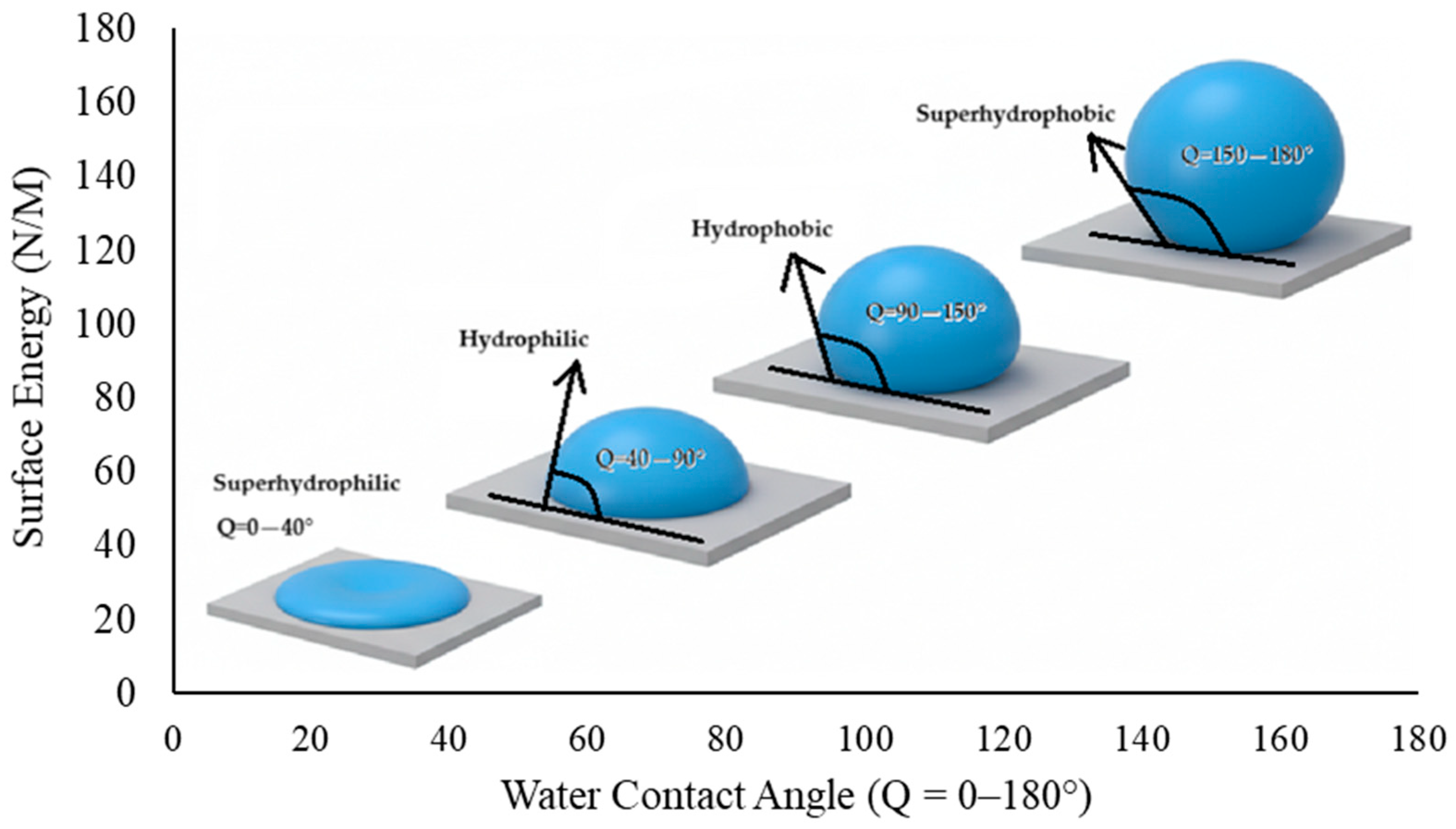






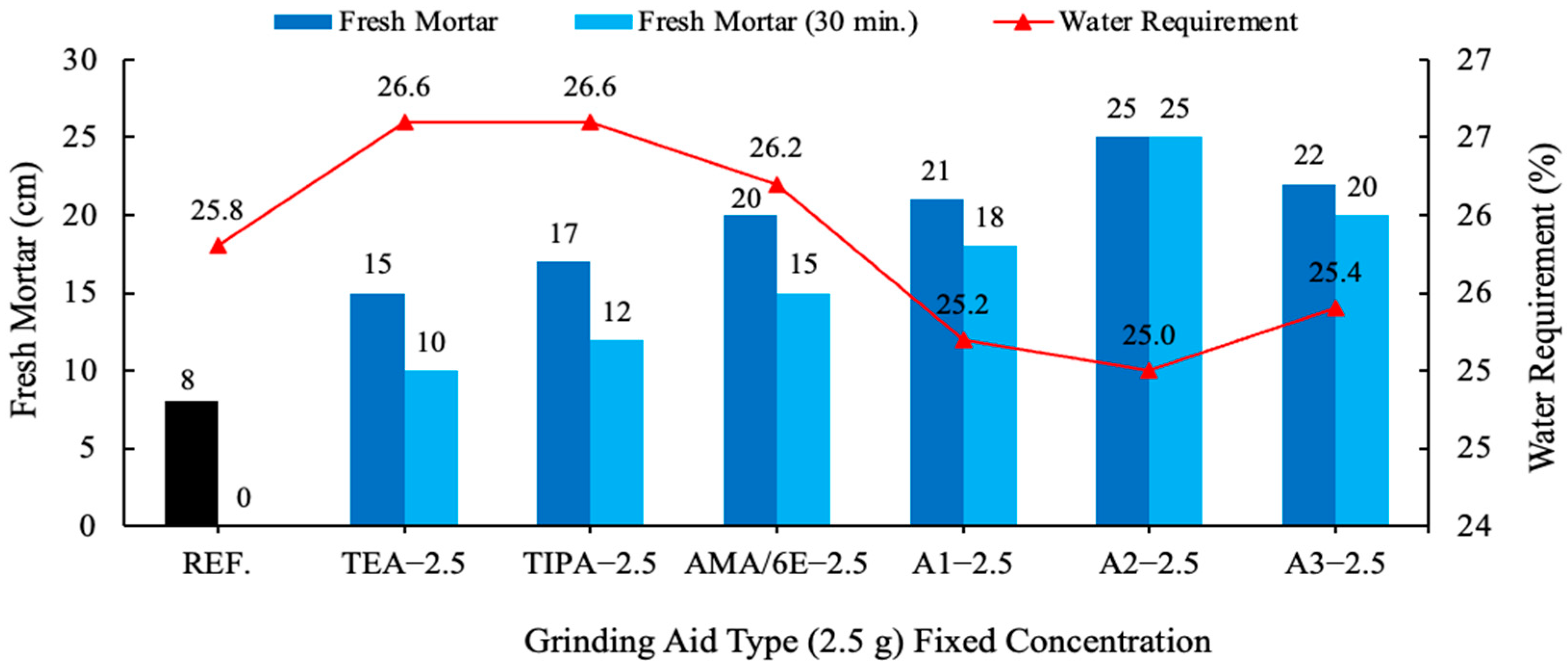
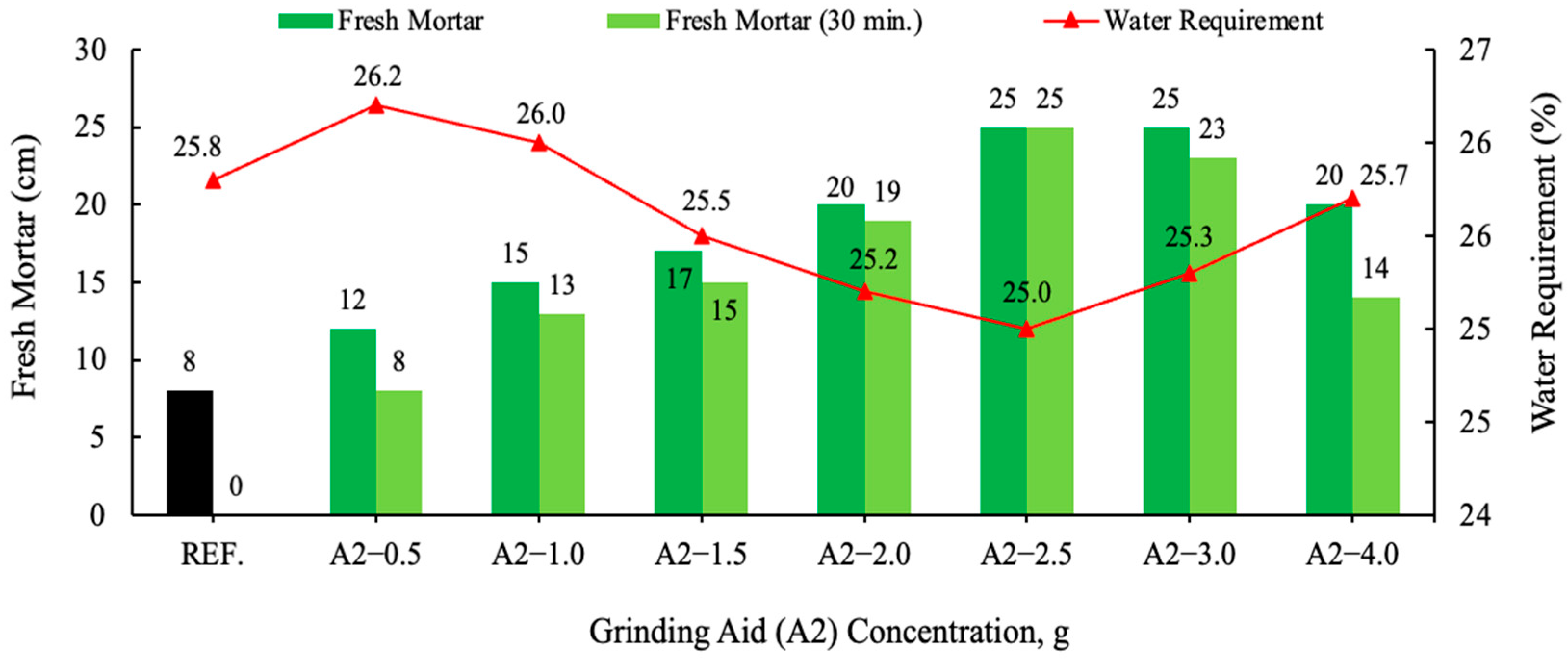
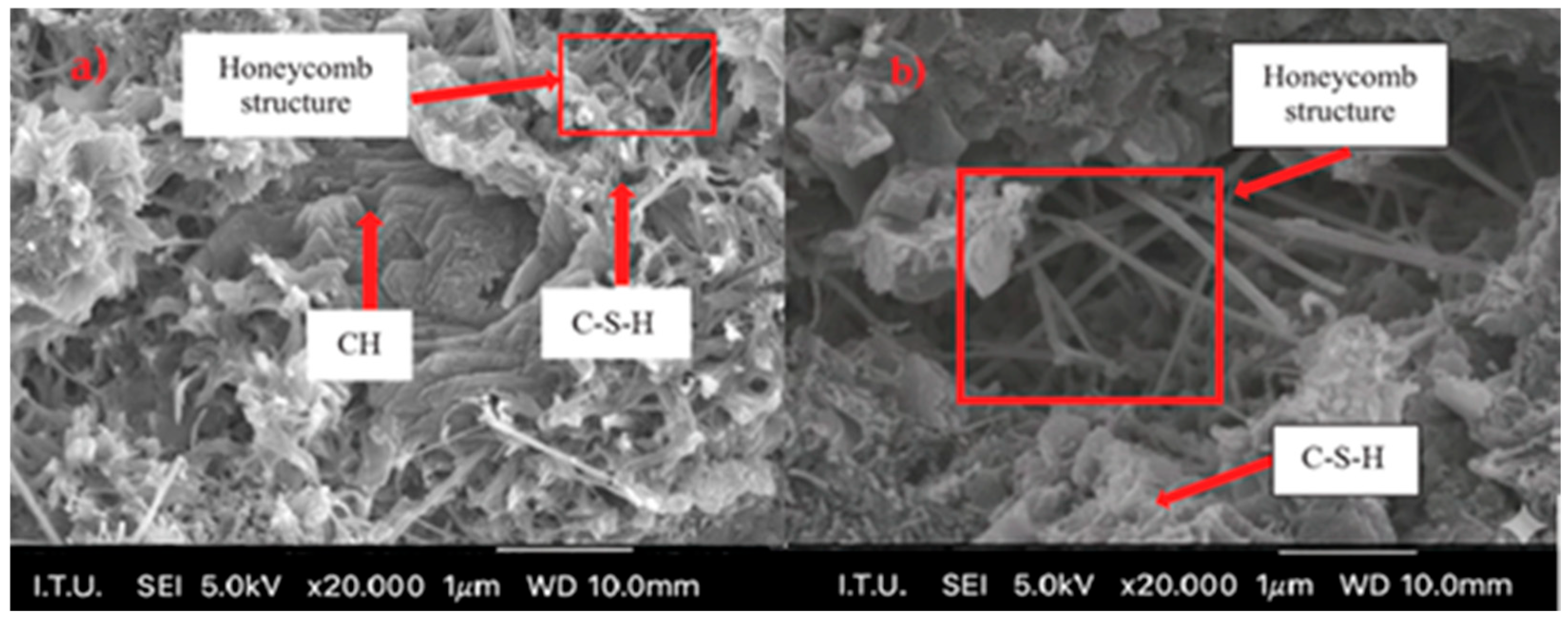
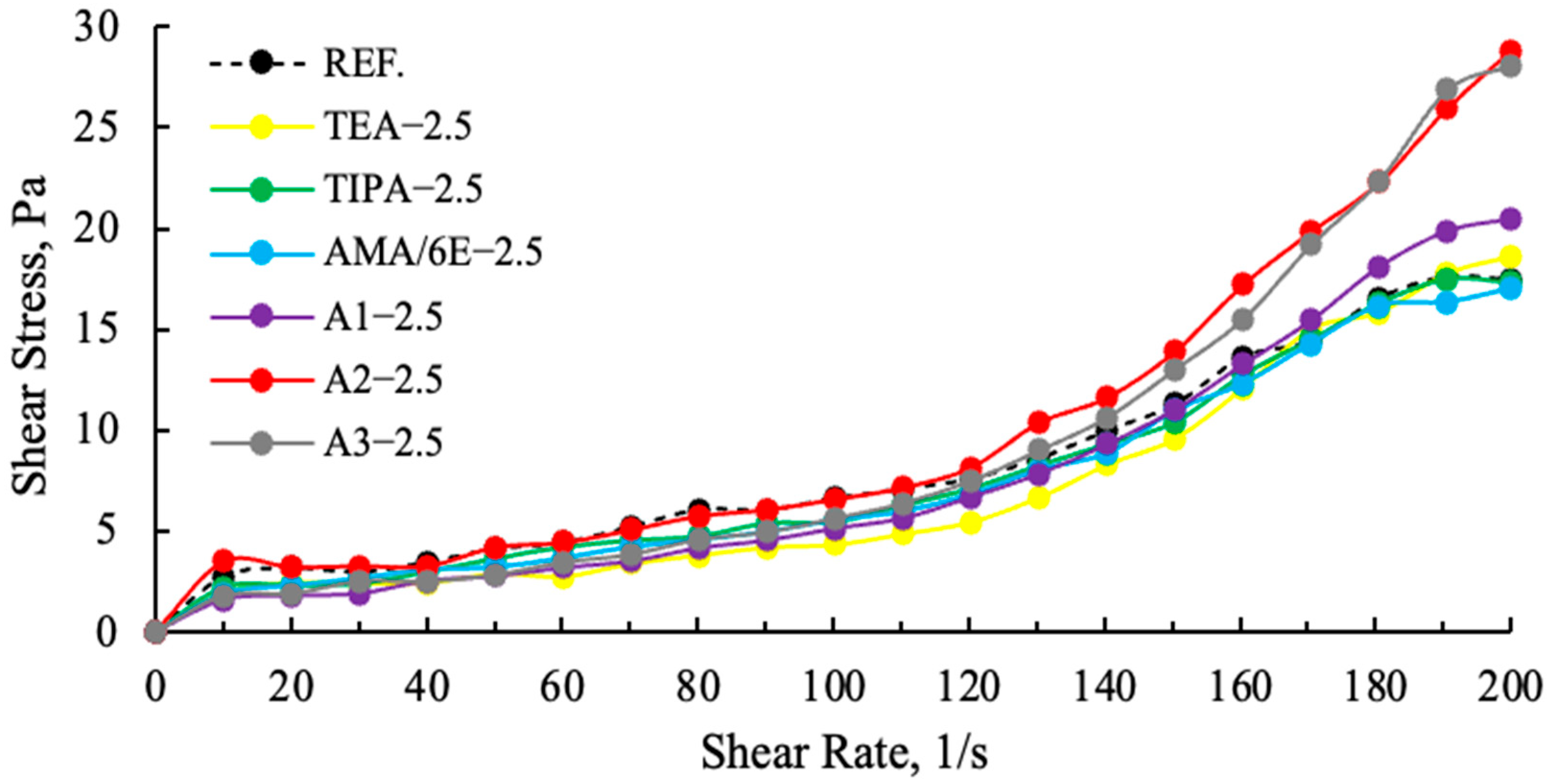


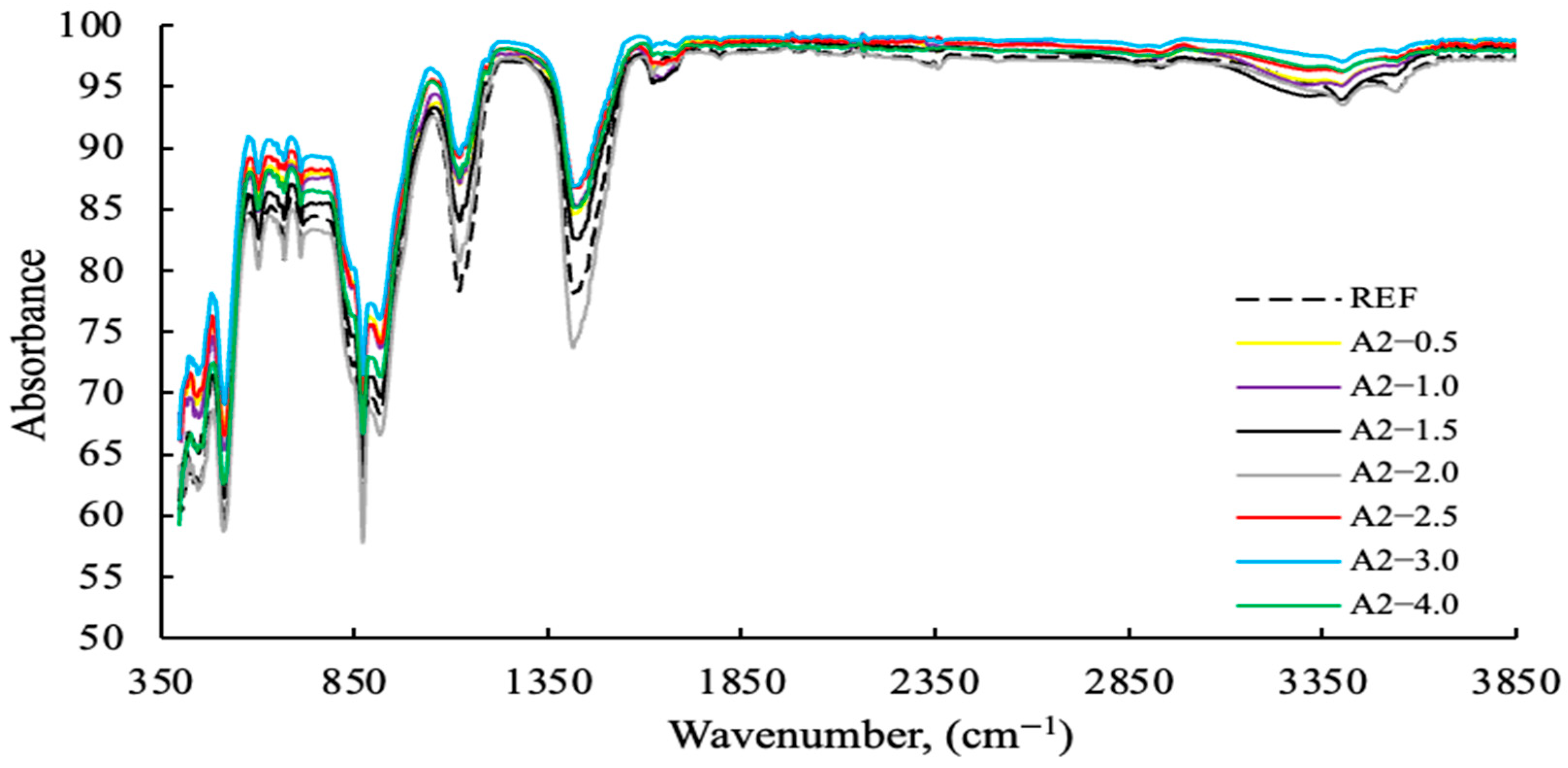

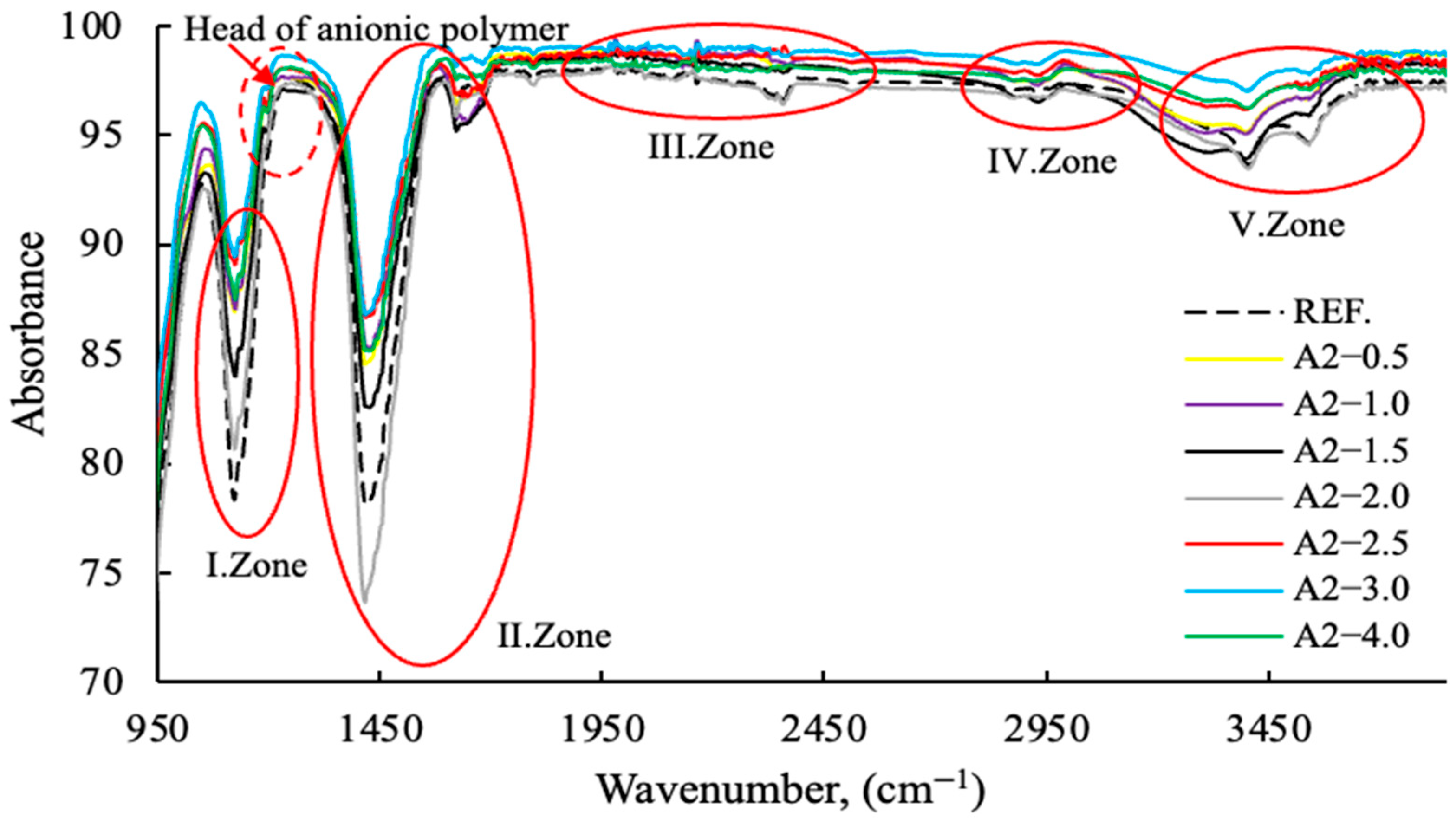
| Oxides | SiO2 | Al2O3 | Fe2O3 | CaO | MgO | SO3 | LOI | Na2O | K2O | Cr2O3 | Mn3O4 |
|---|---|---|---|---|---|---|---|---|---|---|---|
| Wt (%) | 20.55 | 4.71 | 3.55 | 66.63 | 1.58 | 1.28 | 0.44 | 0.12 | 0.91 | 0.04 | 0.19 |
| Polymer | TEA | TIPA | AMA/6E | A1 | A2 | A3 |
|---|---|---|---|---|---|---|
| Solid rate (%) | 88 | 78 | 52 | 50 | 50 | 50 |
| pH | 11.60 | 7.80 | 5.60 | 5.80 | 5.73 | 6.00 |
| Color | Transparent | Transparent | Brown | Light Yellow | Transparent | Transparent |
| Density(g/cm3) | 1.12 | 1.02 | 1.07 | 1.05–1.15 | 1.05–1.15 | 1.05–1.15 |
| Molecular W. (g/mol) | 149.19 | 191.27 | 58,700 | 59,000 | 60,000 | 58,900 |
| Grinding Aid Type and Concentration | Various Types of Grinding aid Recipes for a 100mL Solution |
|---|---|
| Reference | 100 g water |
| TEA—2.5 g | 12.5 TEA g + 87.5 g water |
| TIPA—2.5 g | 12.5 TIPA g + 87.5 g water |
| AMA/6E—2.5 g | 12.5 AMA/6E g + 87.5 g water |
| A1—2.5 g | 12.5 A1 g + 87.5 g water |
| A2—0.5 g | 2.5 A2 g + 97.5 g water |
| A2—1.0 g | 5.0 A2 g + 95.0 g water |
| A2—1.5 g | 7.5 A2 g + 92.5 g water |
| A2—2.0 g | 10.0 A2 g + 90.0 g water |
| A2—2.5 g | 12.5 A2 g + 87.5 g water |
| A2—3.0 g | 15.0 A2 g + 85.0 g water |
| A2—4.0 g | 20.0 A2 g + 80.0 g water |
| A3—2.5 g | 12.5 A3 g + 87.5 g water |
| Wavenumber (cm−1) | Interpretation |
|---|---|
| 950 | Attributed to silicate phases; associated with Si–O stretching vibrations [45]. |
| 950–1100 | A2 is a polymer-based grinding chemical which demonstrates the highest wavelength dispersion at 2.5 g. In this region, TEA-TIPA and Ref. exhibit the lowest wavelength dispersion [46,47]. |
| 1100 | Assigned to sulfate phases; corresponds to S–O stretching vibrations [45,47]. |
| 1150–1250 | Head of anionic polymer group [48]. |
| 1150–1350 | This is the point at which the heads of the chemicals interact. The finding that A2—2.5 g polymer-based grinding chemicals exhibit a higher wavelength than the amine group grinding chemicals and the reference cement serves to substantiate the dispersion effect of polymers on the grinding process [48]. |
| 1380 | Surfactant tail group; CH3–R bending vibration [49]. |
| 1420 | Surfactant tail group; CH2 bending vibration [49]. |
| 1468 | Surfactant tail group; CH2 bending vibration [46]. |
| 1380−1580 (broad band) | Region characteristic of surfactant head groups and tail modes; in cationic or nonionic surfactants, a broad absorption feature is typically observed [49]. |
| 1950-2450 | Surfactant chain; strong Si−OH bending. Silanols have been demonstrated to render the system either hydrophobic or hydrophilic [50]. |
| 2850 | Surfactant alkyl chain; distinct CH3 stretching vibration [47]. |
| 2870 | Surfactant alkyl chain; weak CH3 stretching vibration [47]. |
| 2920 | Surfactant alkyl chain; distinct CH3 stretching vibration [47]. |
| 2955 | Surfactant alkyl chain; weak CH3 stretching vibration [47]. |
| 2900−3500 | This phenomenon is associated with the retention of water molecules between the molecules of a substance. In this region, A2—2.5 g polymer-based grinding chemicals have demonstrated a reduced water demand in comparison to amine groups [47]. |
| 3200−3450 | Water-associated region; reflects structural and chemical changes of water molecules adsorbed onto the cement particle surface [47]. |
Disclaimer/Publisher’s Note: The statements, opinions and data contained in all publications are solely those of the individual author(s) and contributor(s) and not of MDPI and/or the editor(s). MDPI and/or the editor(s) disclaim responsibility for any injury to people or property resulting from any ideas, methods, instructions or products referred to in the content. |
© 2025 by the authors. Licensee MDPI, Basel, Switzerland. This article is an open access article distributed under the terms and conditions of the Creative Commons Attribution (CC BY) license (https://creativecommons.org/licenses/by/4.0/).
Share and Cite
Çinku, K.; Dengiz Özcan, E.; Özdamar, Ş.; Ergin, H. Optimizing the Cement Rheology and Hydrophobicity Using Polycarboxylate Ether (PCE)-Based Grinding Aids. Polymers 2025, 17, 3002. https://doi.org/10.3390/polym17223002
Çinku K, Dengiz Özcan E, Özdamar Ş, Ergin H. Optimizing the Cement Rheology and Hydrophobicity Using Polycarboxylate Ether (PCE)-Based Grinding Aids. Polymers. 2025; 17(22):3002. https://doi.org/10.3390/polym17223002
Chicago/Turabian StyleÇinku, Kenan, Ebru Dengiz Özcan, Şenel Özdamar, and Hasan Ergin. 2025. "Optimizing the Cement Rheology and Hydrophobicity Using Polycarboxylate Ether (PCE)-Based Grinding Aids" Polymers 17, no. 22: 3002. https://doi.org/10.3390/polym17223002
APA StyleÇinku, K., Dengiz Özcan, E., Özdamar, Ş., & Ergin, H. (2025). Optimizing the Cement Rheology and Hydrophobicity Using Polycarboxylate Ether (PCE)-Based Grinding Aids. Polymers, 17(22), 3002. https://doi.org/10.3390/polym17223002







